Coffee Drinking and Emotions: Are There Key Sensory Drivers for Emotions? †
Abstract
1. Introduction
2. Materials and Methods
2.1. Descriptive Panel
2.2. Coffee Samples
2.3. Descriptive Sensory Analysis
2.3.1. Sample Preparation and Serving
2.3.2. Sample Evaluation
2.4. Emotion Data
2.5. Statistical Analyses
3. Results and Discussion
3.1. Descriptive Sensory Data
3.2. Identifying Sensory Drivers for the Emotional Experience
4. Conclusions
Author Contributions
Funding
Conflicts of Interest
Appendix A
| Active | Disgusted | Jolted | Relaxed |
| Annoyed | Educated | Joyful | Rested |
| Awake | Empowering | Jumpstart | Rewarded |
| Balanced | Energetic | Merry | Satisfied |
| Boosted | Free | Motivated | Social |
| Bored | Fulfilling | Nervous | Soothing |
| Clear-minded | Fun | Off-balance | Special |
| Comfortable | Good | Peaceful | Understanding |
| Content | Grouchy | Pleasant | Warm |
| Curious | Guilty | Pleased | Wild |
| Disappointed | In-control | Productive | Worried |
Appendix B
| Cluster | Breakfast | Italian | Kona | Nantucket | Newman | Sumatra |
| C1 (n = 20) | 7.7 | 6.9 | 7.3 | 7.7 | 7.5 | 7.2 |
| C2 (n = 17) | 4.4 | 6.9 | 6.7 | 6.1 | 7.2 | 6.5 |
| C3 (n = 24) | 7.0 | 6.0 | 5.8 | 7.5 | 5.3 | 3.7 |
| C4 (n = 13) | 4.6 | 3.5 | 5.7 | 6.0 | 5.5 | 5.4 |
| C5 (n = 10) | 7.1 | 3.3 | 3.5 | 4.1 | 2.2 | 2.1 |
| C6 (n = 10) | 5.9 | 6.4 | 7.0 | 3.6 | 5.1 | 6.1 |
References
- Chrea, C.; Grandjean, D.; Delplanque, S.; Cayeux, I.; Le Calve, B.; Aymard, L.; Velazco, M.I.; Sander, D.; Scherer, K. Mapping the semantic space for the subjective experience of emotional responses to odors. Chem. Senses 2009, 34, 49–62. [Google Scholar] [CrossRef] [PubMed]
- Porcherot, C.; Delplanque, S.; Raviot-Derrien, S.; Le Calve, B.; Chrea, C.; Gaudreau, N.; Cayeux, I. How do you feel when you smell this? Optimization of a verbal measurement of odor-elicited emotions. Food Qual. Prefer. 2010, 21, 938–947. [Google Scholar] [CrossRef]
- Thomson, D.M.H. Sensory Cues for Emotional Responses to Foods & Drinks. International Union of Food Science and Technology (IUFoST), 2006. Available online: http://dx.doi.org/10.1051/IUFoST:20061091 (accessed on 1 December 2018).
- Thomson, D.M.H.; Crocker, C.; Marketo, C.G. Linking sensory characteristics to emotions: An example using dark chocolate. Food Qual. Prefer. 2010, 21, 1117–1125. [Google Scholar] [CrossRef]
- Gibson, E.L. Emotional influences on food choice: Sensory, physiological and psychological pathways. Physiol. Behav. 2006, 89, 53–61. [Google Scholar] [CrossRef] [PubMed]
- King, S.C.; Meiselman, H.L. Development of a method to measure consumer emotions associated with foods. Food Qual. Prefer. 2009, 21, 168–177. [Google Scholar] [CrossRef]
- Bhumiratana, N.; Adhikari, K.; Chambers, E., IV. The development of an emotion lexicon for the coffee drinking experience. Food Res. Int. 2014, 61, 83–92. [Google Scholar] [CrossRef]
- Illy, E. The complexity of coffee. Sci. Am. 2002, 286, 86–91. [Google Scholar] [CrossRef]
- Grosch, W. Flavour of coffee: A review. Nahrung 1998, 42, 344–350. [Google Scholar] [CrossRef]
- Czerny, M.; Mayer, F.; Grosch, W. Sensory study on the character impact odorants of roasted Arabica coffee. J. Agric. Food Chem. 1999, 47, 695–699. [Google Scholar] [CrossRef]
- Illy, A.; Viani, R. Espresso Coffee: The Science of Quality, 2nd ed.; Elsevier Academic Press: London, UK, 2005. [Google Scholar]
- Di Donfrancesco, B.; Gutierrez Guzman, N.; Chambers, E., IV. Comparison of results from cupping and descriptive sensory analysis of Colombian brewed coffee. J. Sens. Stud. 2014, 29, 301–311. [Google Scholar] [CrossRef]
- Bhumiratana, N.; Adhikari, K.; Chambers, E., IV. Green coffee beans to brewed coffee: Evolution of coffee aroma. LWT-Food Sci. Technol. 2011, 44, 2185–2192. [Google Scholar] [CrossRef]
- Chambers, D.H.; Allison, A.; Chambers, E., IV. Training effects on performance of descriptive panelists. J. Sens. Stud. 2004, 19, 486–499. [Google Scholar] [CrossRef]
- Chambers, E., IV; Smith, E.A. Effects of testing experience on performance of trained sensory panelists. J. Sens. Stud. 1993, 8, 155–166. [Google Scholar]
- Wolters, C.J.; Allchurch, E.M. Effect of training procedure on the performance of descriptive panels. Food Qual. Prefer. 1994, 5, 203–214. [Google Scholar] [CrossRef]
- Bitnes, J.; Ueland, O.; Moller, P.; Martens, M. Reliability of sensory assessors: Issues of retention and learning. J. Sens. Stud. 2008, 23, 852–870. [Google Scholar] [CrossRef]
- Chambers, E., IV; Sanchez, K.; Phan, U.T.X.; Miller, R.; Civille, G.V.; Di Donfrancesco, B. Development of a “living” lexicon for descriptive sensory analysis of brewed coffee. J. Sens. Stud. 2016, 31, 465–480. [Google Scholar] [CrossRef]
- Jager, G.; Schlich, P.; Tijjsen, I.; Yao, J.; Visalli, M.; de Graaf, C.; Steiger, M. Temporal dominance of emotions: Measuring dynamics of food-related emotions during consumption. Food Qual. Prefer. 2014, 37, 87–99. [Google Scholar] [CrossRef]
- Schenker, S.; Heinemann, C.; Huber, M.; Pompizzi, R.; Perren, R.; Escher, F. Impact of roasting conditions on the formation of aroma compounds in coffee beans. J. Food Sci. 2002, 67, 60–66. [Google Scholar] [CrossRef]
- Yeretzian, C.; Jordan, A.; Badoud, R.; Lindinger, W. From the green bean to the cup of coffee: Investigating coffee roasting by on-line monitoring of volatiles. Eur. Food Res. Technol. 2002, 214, 92–104. [Google Scholar] [CrossRef]
- Baggenstoss, J.; Poisson, L.; Kaegi, R.; Perren, R.; Escher, F. Coffee roasting and aroma formation: Application of different time and temperature conditions. J. Agric. Food Chem. 2008, 56, 5836–5846. [Google Scholar] [CrossRef]
- Mayer, F.; Czerny, M.; Grosch, W. Influence of provenance and roast degree on the composition of potent odorants in Arabica coffees. Eur. Food Res. Technol. 1999, 209, 242–250. [Google Scholar] [CrossRef]
- Decazy, F.; Avelino, J.; Guyot, B.; Perriot, J.J.; Pineda, C.; Cilas, C. Quality of different Honduran coffees in relation to several environments. J. Food Sci. 2003, 68, 2356–2361. [Google Scholar] [CrossRef]
- Nebesny, E.; Budryn, G. Evaluation of sensory attributes of coffee brews from robusta coffee roasted under different conditions. Eur. Food Res. Technol. 2006, 224, 159–165. [Google Scholar] [CrossRef]
- Ross, C.F.; Pecka, K.; Weller, K. Effect of storage conditions on the sensory quality of ground Arabica coffee. J. Food Qual. 2006, 29, 596–606. [Google Scholar] [CrossRef]
- Seo, H.S.; Hirano, M.; Shibato, M.; Rakwal, R.; Hwang, I.K.; Masuo, Y. Effect of coffee bean aroma on the rat brain stressed by sleep deprivation: A selected transcript and 2D get-based proteome analysis. J. Agric. Food Chem. 2008, 56, 4665–4673. [Google Scholar] [CrossRef] [PubMed]
- Macht, M.; Mueller, J. Immediate effects of chocolate on experimentally induced mood states. Appetite 2007, 49, 667–674. [Google Scholar] [CrossRef] [PubMed]
- Richins, M.L. Measuring emotions in the consumption experience. J. Cons. Res. 1997, 24, 127–146. [Google Scholar] [CrossRef]
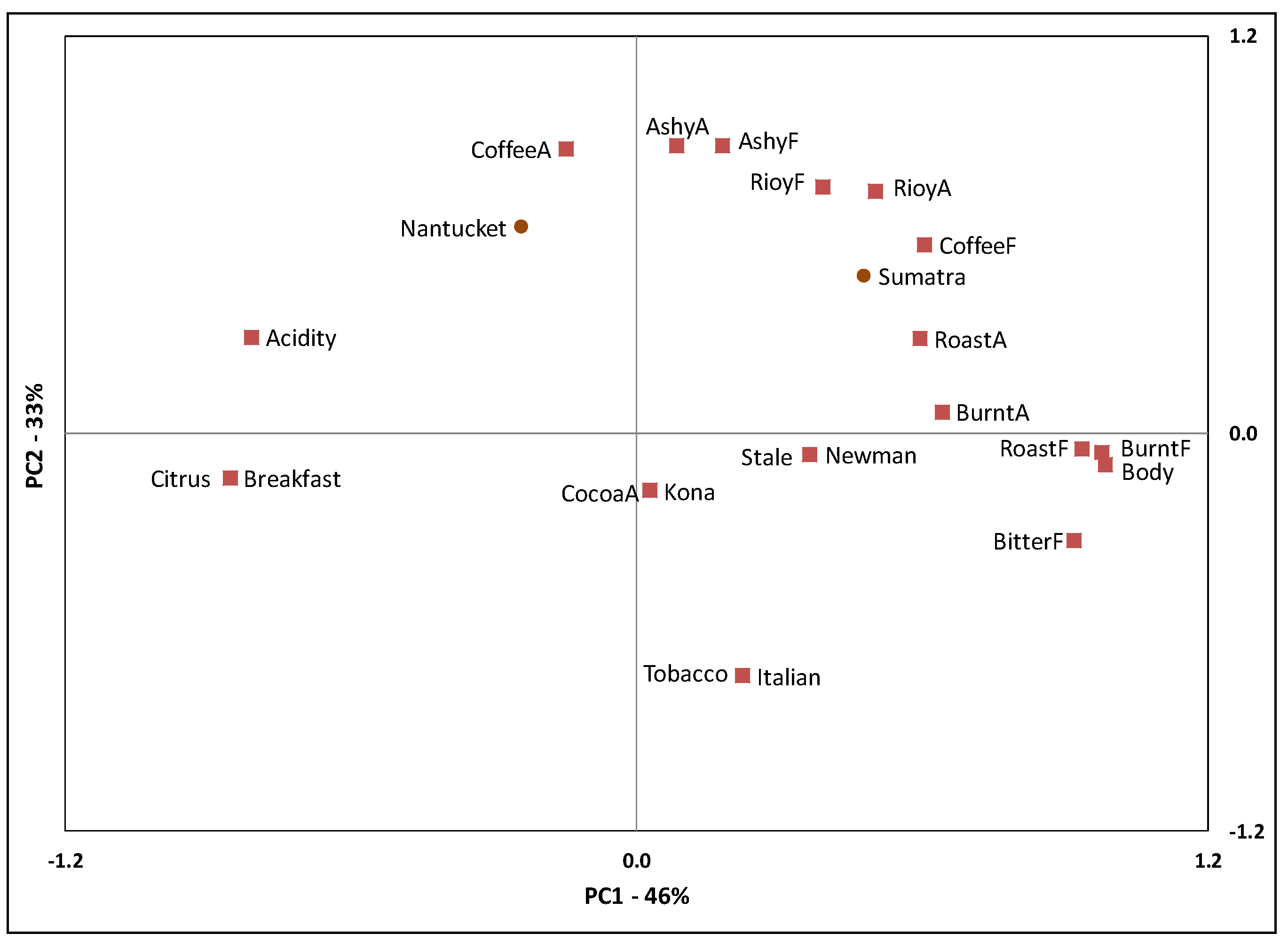


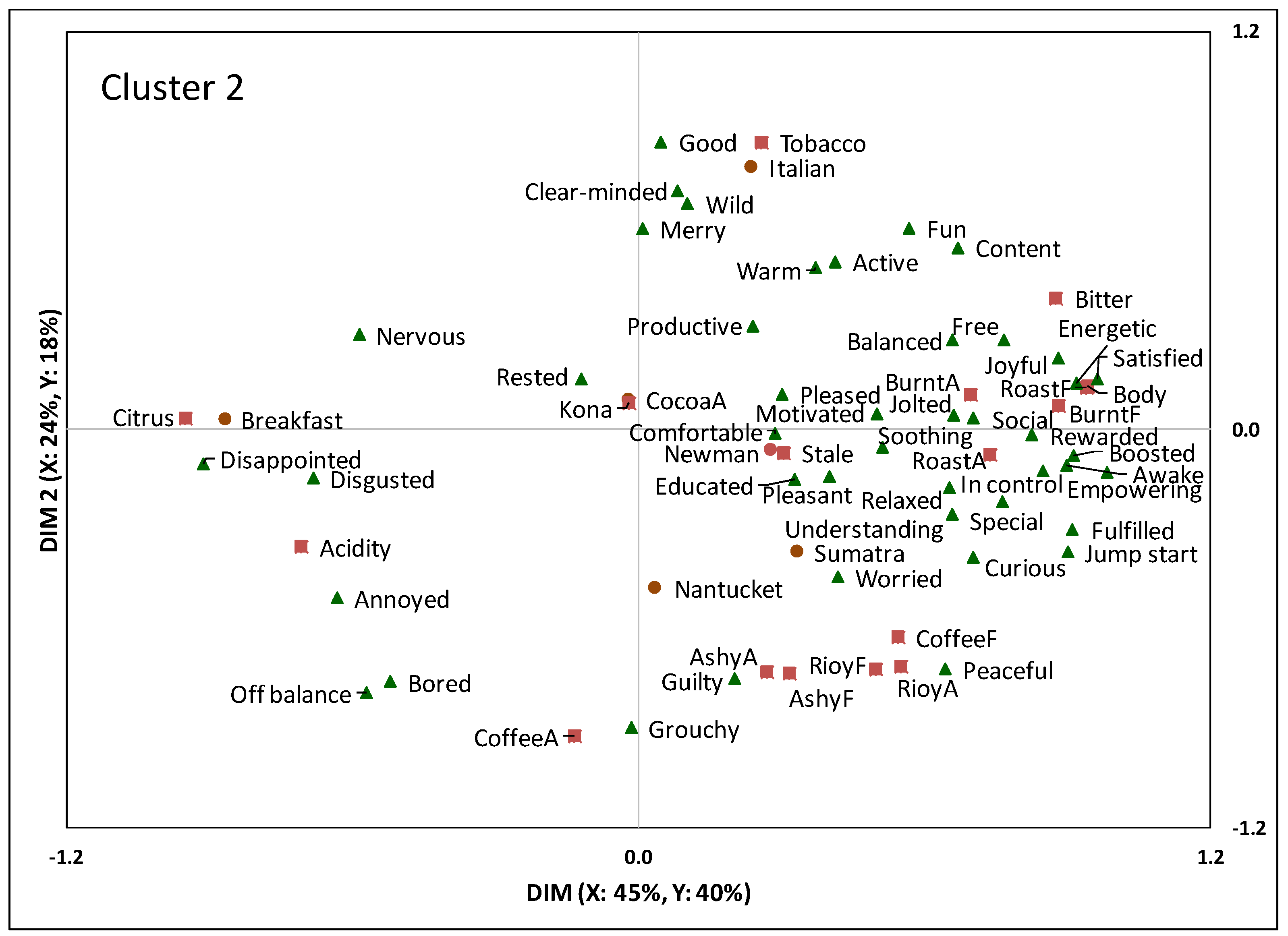
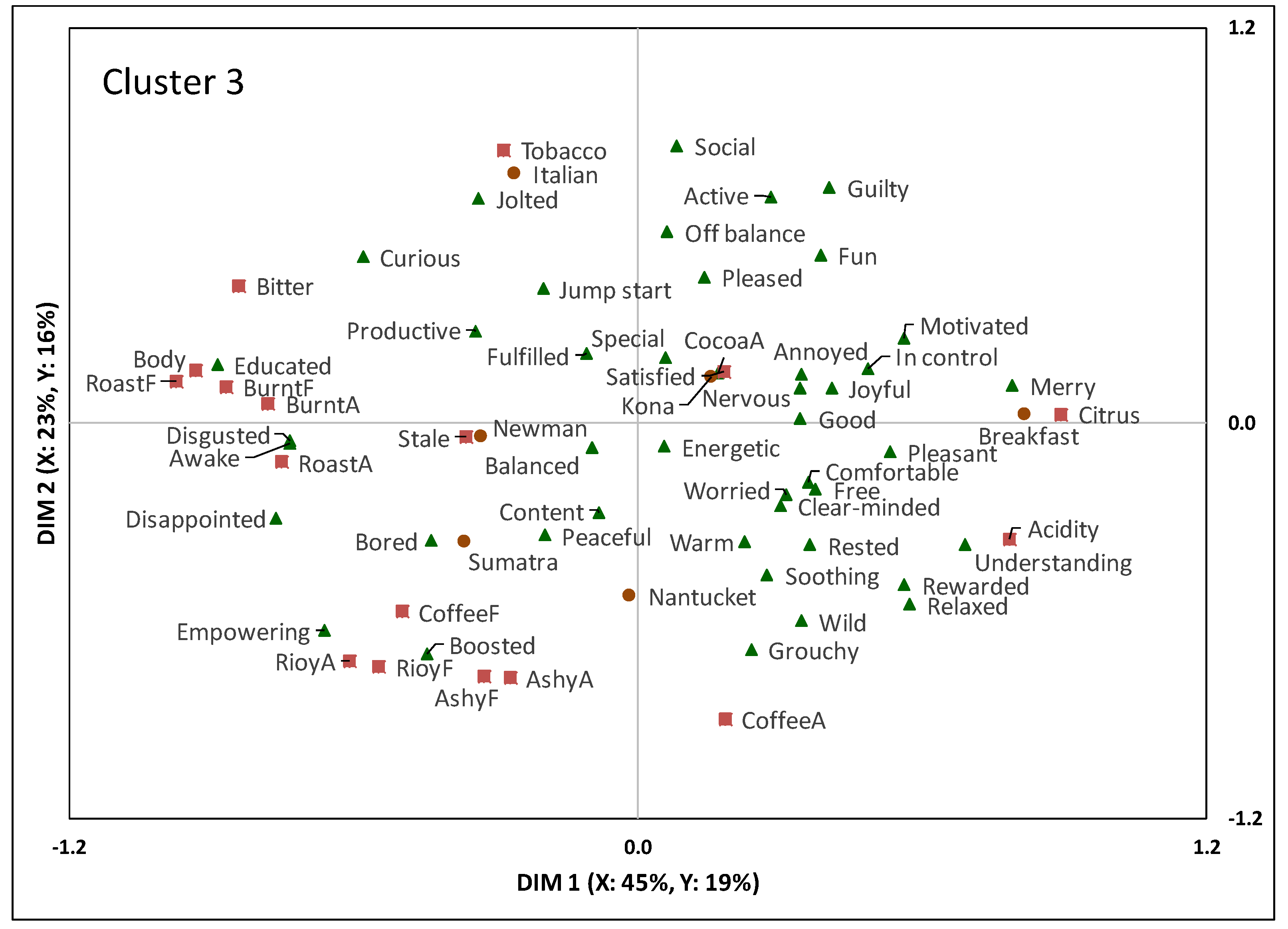
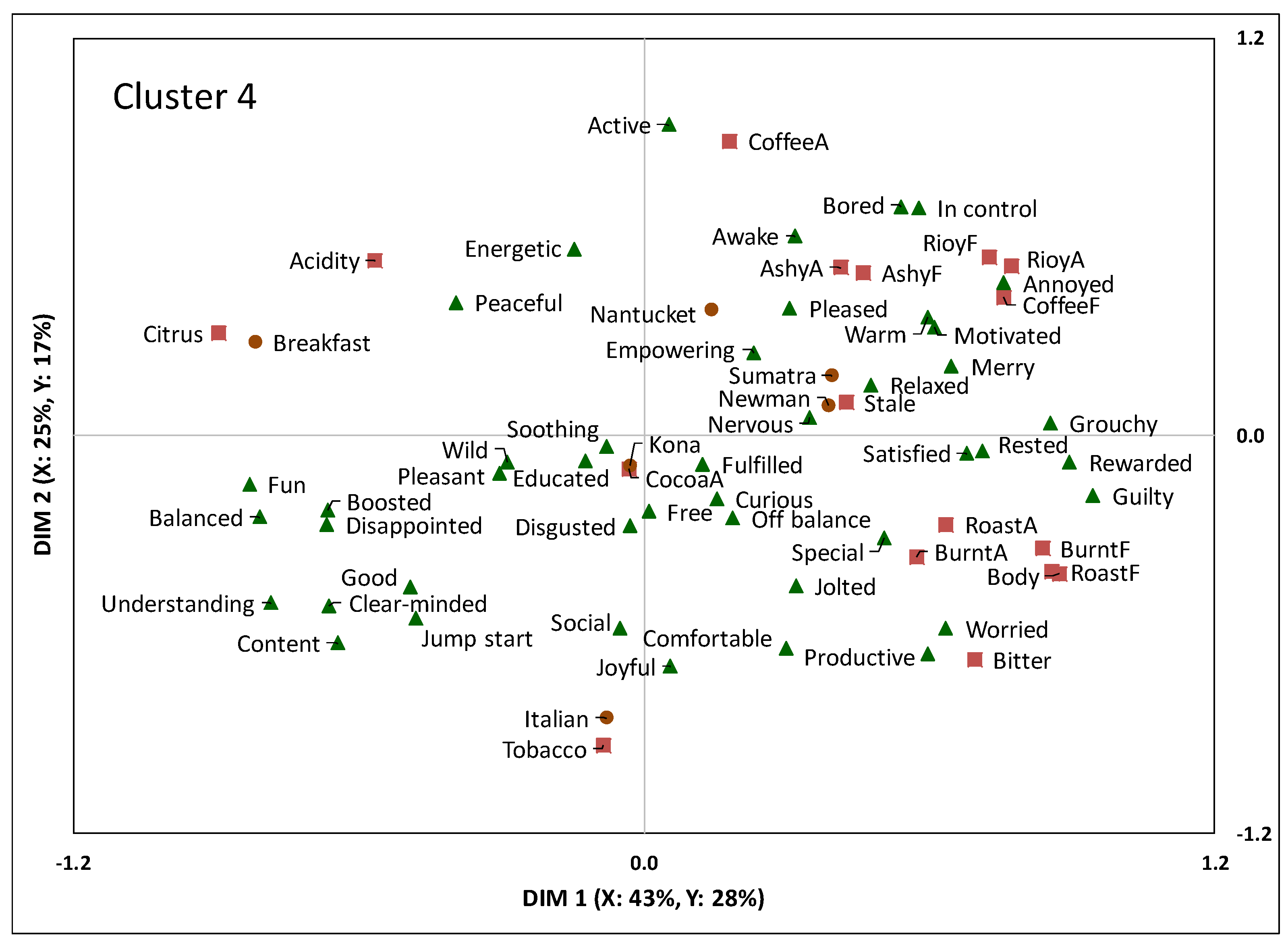
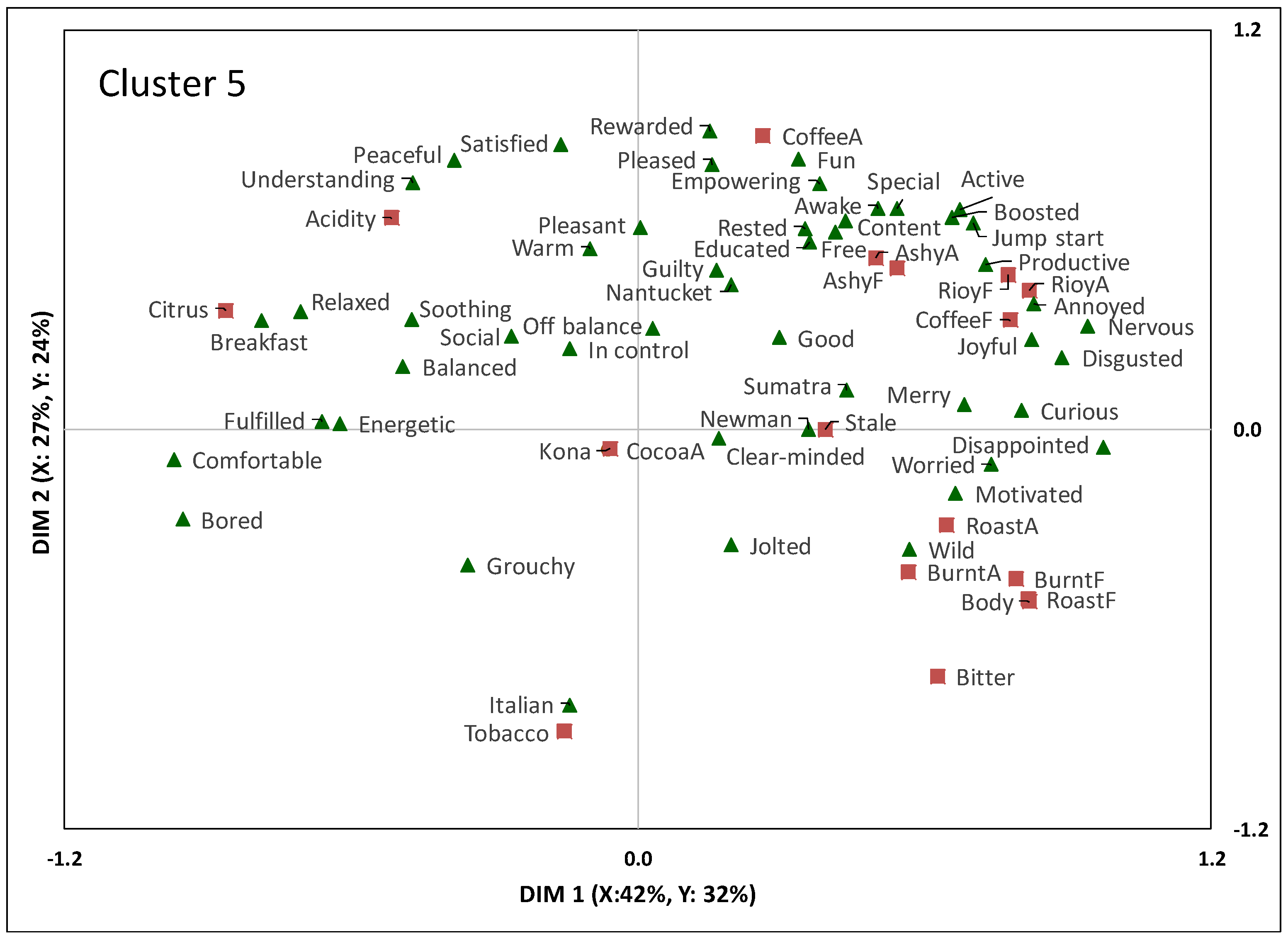
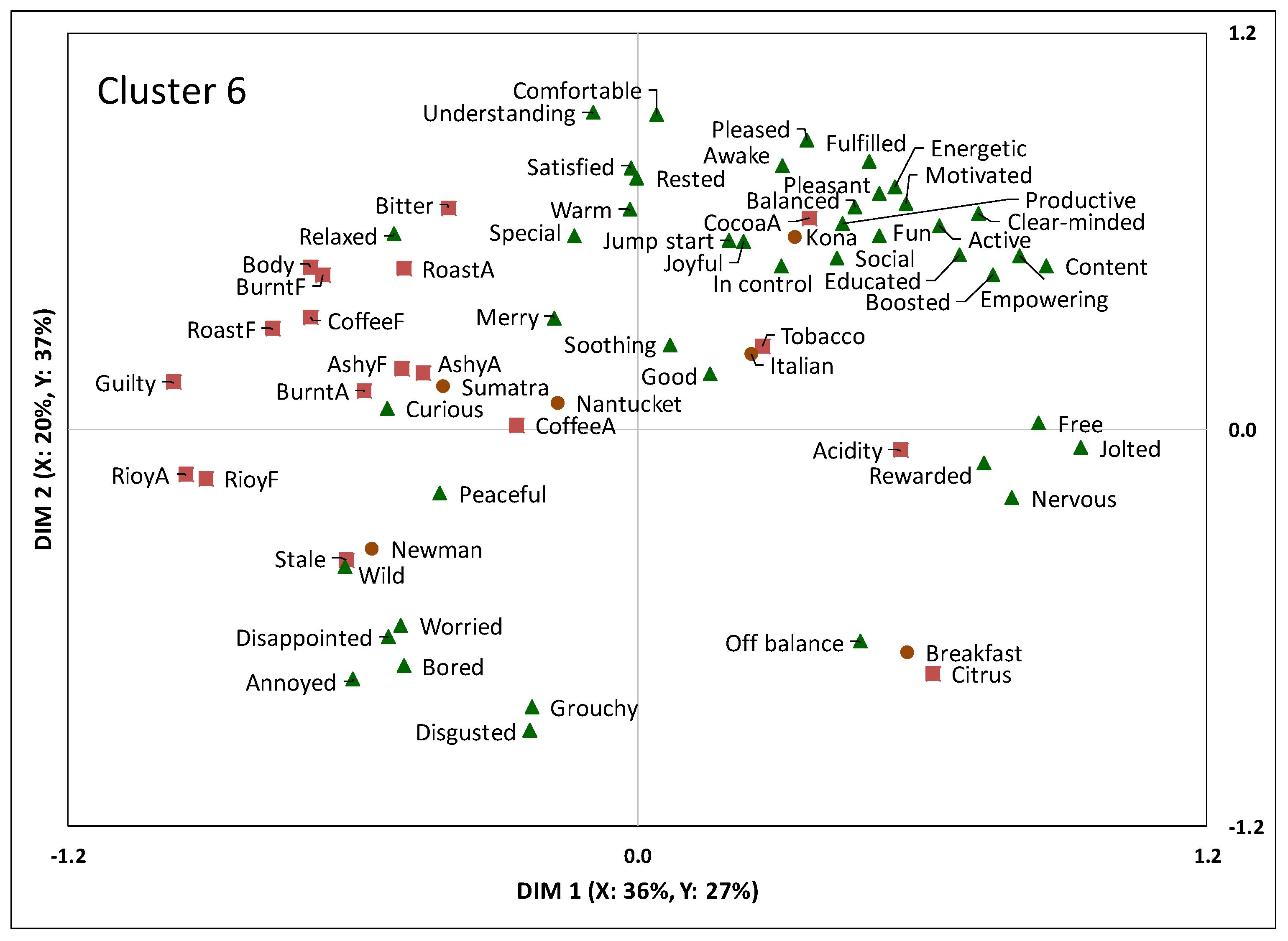
| Attributes. | Definitions |
|---|---|
| Coffee | Amount or strength of Arabica coffee aroma or flavor |
| Roast | Degree to which the coffee is roasted; ranges from green/no roast–low–medium–dark–very dark |
| Burnt | Aromatics associated with blacked/acrid carbohydrates (e.g., burnt toast, espresso coffee) |
| Rioy | Aromatic associated with iodine in water; is described as chlorine-like, brassy, metallic, and chemical |
| Ashy | Bark-like lingering aromatics associated with a cold campfire |
| Acidity | A sour, sharp, puckering sensation in the mouth caused by acids |
| Tobacco | Characteristic reminiscent of tobacco’s odor and taste, but should not be used for burnt tobacco |
| Stale | Not fresh, flat, bodied down or reduced; old |
| Citrus | Aromatics associated with citrus fruits (e.g., lemon) |
| Cocoa | Brown, sweet, dusty often biter aromatics associated with cocoa beans and powered cocoa |
| Bitter | The amount of bitter basic taste; (e.g., caffeine solutions) |
| Body (Mouthfeel) | Viscosity of the coffee; heaviness on the tongue: thin to thick |
| Descriptors | Abbreviation for Figures | Breakfast | Italian | Kona | Nantucket | Newman | Sumatra |
|---|---|---|---|---|---|---|---|
| Aroma | |||||||
| Coffee | CoffeeA | 7.79 ab | 5.42 c | 8.33 a | 8.58 a | 7.50 ab | 8.58 a |
| Roast | RoastA | 6.92 b | 8.50 a | 7.42 b | 8.50 a | 7.58 b | 8.58 a |
| Burnt | BurntA | 0.67 c | 4.50 a | 0.17 c | 2.92 b | 2.83 b | 4.33 a |
| Rioy | RioyA | 0.00 b | 0.00 b | 0.00 b | 1.33 a | 1.58 a | 1.58 a |
| Ashy | AshyA | 0.00 b | 0.00 b | 0.00 b | 2.75 a | 0.00 b | 1.92 a |
| Cocoa | CocoaA | 0.00 b | 0.00 b | 2.33 a | 0.00 b | 0.00 b | 0.00 b |
| Flavor | |||||||
| Coffee | CoffeeF | 8.25 c | 8.00 c | 11.75 a | 10.33 b | 11.75 a | 12.50 a |
| Roast | RoastF | 7.08 c | 10.17 a | 8.54 b | 8.92 b | 10.50 a | 10.08 a |
| Burnt | BurntF | 1.58 d | 6.67 b | 6.75 b | 3.75 c | 8.33 a | 8.50 a |
| Rioy | RioyF | 0.00 b | 0.00 b | 0.00 b | 2.04 a | 2.00 a | 1.58 a |
| Ashy | AshyF | 0.00 b | 0.00 b | 0.00 b | 2.92 a | 0.00 b | 2.83 a |
| Citrus | Citrus | 4.42 a | 0.00 b | 0.00 b | 0.00 b | 0.00 b | 0.00 b |
| Tobacco | Tobacco | 0.00 b | 8.08 a | 0.00 b | 0.00 b | 0.00 b | 0.00 b |
| Stale | Stale | 0.00 b | 0.00 b | 0.00 b | 0.00 b | 4.42 a | 0.00 b |
| Acidity | Acidity | 5.92 a | 4.83 c | 5.83 ab | 5.92 a | 4.92 c | 4.92 c |
| Bitter | Bitter | 3.08 d | 9.50 a | 8.13 b | 5.42 c | 8.00 b | 8.42 b |
| Texture | |||||||
| Body | Body | 6.38 d | 8.67 ab | 8.33 b | 7.63 c | 9.13 a | 8.83 ab |
© 2019 by the authors. Licensee MDPI, Basel, Switzerland. This article is an open access article distributed under the terms and conditions of the Creative Commons Attribution (CC BY) license (http://creativecommons.org/licenses/by/4.0/).
Share and Cite
Bhumiratana, N.; Wolf, M.; Chambers IV, E.; Adhikari, K. Coffee Drinking and Emotions: Are There Key Sensory Drivers for Emotions? Beverages 2019, 5, 27. https://doi.org/10.3390/beverages5020027
Bhumiratana N, Wolf M, Chambers IV E, Adhikari K. Coffee Drinking and Emotions: Are There Key Sensory Drivers for Emotions? Beverages. 2019; 5(2):27. https://doi.org/10.3390/beverages5020027
Chicago/Turabian StyleBhumiratana, Natnicha, Mona Wolf, Edgar Chambers IV, and Koushik Adhikari. 2019. "Coffee Drinking and Emotions: Are There Key Sensory Drivers for Emotions?" Beverages 5, no. 2: 27. https://doi.org/10.3390/beverages5020027
APA StyleBhumiratana, N., Wolf, M., Chambers IV, E., & Adhikari, K. (2019). Coffee Drinking and Emotions: Are There Key Sensory Drivers for Emotions? Beverages, 5(2), 27. https://doi.org/10.3390/beverages5020027






